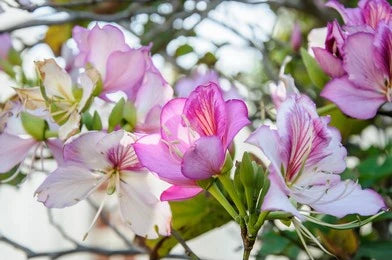A small to medium-sized deciduous tree with a spreading crown and a short bole, kachnar grows to a height of up to 15 m. The tree's twigs are skinny, angled, light green, hairy, and brownish-grey in hue. The inner bark is pinkish in color, fibrous, and bitter. The outside bark is scaly, smooth to slightly fissured, and brownish-grey in color. The tree's leaves are oblong to round, bi-lobed, 10–13 nerved and glabrous on their upper surfaces. The plant's leaves resemble the pattern left by a camel's hoof. Flowers with five slightly overlapping, irregularly shaped petals in shades of yellow and pinkish purple are reminiscent of showy orchids. The flower cluster at the end of the twigs is unbranched. Scented flowers appear for the first time in late winter when the tree is leafless. Fruit is a dehiscent pod that is strap-shaped and roughly 15-30cm long, containing numerous flat seeds.
General Information
When in bloom, the Kachnar tree is regarded as one of the most beautiful trees in the world. It is closely related to the peacock flower. Common names for Kachnar include orchid tree, camel's foot tree, mountain ebony, butterfly ash, poor man's orchid, and ebony tree. It is a decorative tree with lovely, fragrant blossoms. Hummingbirds are drawn to this tree in parks and gardens. The kachnar tree's leaves, blossoms, and flower buds are consumed as vegetables.
This tree's buds have a really lovely appearance and taste quite good. The best source of vitamin C is found in the flowers of this plant. It is the best herb for krimi roga (worm infestation), apchi (lymphadenitis), gandmala (scrofula), and varna (wounds) in the Ayurvedic medical system. This herb has antibacterial, antifungal, cytotoxic, anti-inflammatory, pain and fever-relieving, and thyroid-regulating properties. This herb contains active components such as beflavone, flavonolglycoside, triterpine, saponin, phenanthraquninone, and flavonoids.
Habitat
Kachnar is a native of China and India. It is found all over India at an elevation of 1300 meters, increasing in the Himalayan range that extends east to Assam, eastern, central, and southern India. Additionally, Sri Lanka, Pakistan, Nepal, and Burma all have it.
Classification
Kingdom - Plantae
Order - Fabales
Family - Fabaceae
Other Names
Latin name - Bauhinia variegata
English name - Butterfly ash, Camel's foot tree
Hindi name - Kachnar
Bengali name - Kachnar
Kannada name - Basavanpada
Malayalam name - Koral, Kanchan
Manipuri name - Chingtharo
Marathi name - Kovidara, Kanchana
Oriya name - Borodu
Tamil name - Mantharai
Telugu name - Devakanchanamu
French name - Arbe de saint Thomas
Burmese name - Bwechin
Urdu name - Kachnal
Ayurvedic Properties
|
Particular |
Hindi / Sanskrit |
English |
|
Rasa (Taste) |
Kashaya |
Astringent |
|
Guna (Physical Property) |
Laghu, Rooksha |
Light, Dry |
|
Virya (Potency) |
Sheeta |
Cold |
|
Vipaka (Post-Digestive Taste) |
Katu |
Pungent |
Effects on Doshas
It balances Pitta, Kapha and Vata doshas.
|
Charak Samhita |
Sushrut Samhita |
|
|
Practical Uses
Kachnar helps treat menstruation diseases such as anovulation and amenorrhea by balancing out hormonal imbalances. In addition to being very healthy for the entire female reproductive system, kachnar is also very beneficial for a number of disorders in women, including PCOD, hypothyroidism, endometriosis, and uterine fibroids.
- Kachnar works as an anti-microbial and is particularly efficient at shrinking swollen lymph nodes in the neck and groin area.
- This herb also helps nasal polyps, as it shrinks the polyp and facilitates easy breathing.
- This bark's decoction works well for thyroid-related issues and tonsillitis.
- The liver functions better when kachnar leaf extract is used, and it works wonders for jaundice. It is employed to preserve the liver's healthy metabolism and operation.
- The bark decoction is primarily used for skin conditions, but it can also be used as an appetizer and as a gargle for mouth ulcers and poor breath.
- It can also be used as a scraping herb to help obese people lose extra fat.
- It is used to treat painful urination and other urinary tract infections.
- Kachnar is also highly useful for hemorrhoid sufferers.
- The bitter-tasting blooms of this amazing tree are a natural blood purifier, aiding in the removal of poisons and waste from the blood.
- This herb's bark juice is used to treat amoebic dysentery, diarrhea, and other digestive illnesses.
- Kachnar is an anti-diabetic plant with hypoglycemic properties for diabetics.
- It helps to balance the kapha and pitta doshas.
Part Used
Stem bark, Flowers, Leaves, Seeds
Dosage
Decoction - 40-80ml
Flower extract - 10-20ml
Bark powder - 1-3gm

